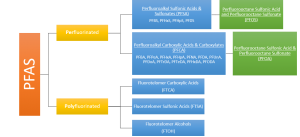PFAS
What is PFAS
Per- and poly-fluorinate alkyl substances are both known as “PFAS” or the “Forever Chemicals”. PFAS is grouped into polymers and non-polymers. Both of these are man-made chemicals have been manufactured for centuries in food packaging, stain repellents, textiles, fire-fighting foam, cleaning products, and military training equipment. PFAS chemicals are beginning to be phased out in the United States in order to eliminate the use of PFOA contamination. PFOA and PFOS is still be manufactured internationally and used in consumer products. The unregulated PFAS compound is also known as “GenX” to the large American chemical company that use it in manufacturing process. Due to the unique molecular structure of PFAS—it is extremely difficult to break it down. Several water treatment processes are resistant to removing PFAS; Hydrosil’s HS-PF works to remove PFAS by means of ion exchange. Ion exchange is used to remove both short and long chain PFAS.
Health Effects of PFAS
Exposure to PFAS has shown several adverse health effects such as cancer, liver and kidney failure, decreased fertility, and thyroid disease. These chemicals have difficulty breaking down in the environment as well as the human body and accumulate over time. PFAS is released to air, solid waste, and water waste which then get into drinking water, groundwater, rainwater, and surface water. Eventually the water is consumed by humans and living organisms where PFAS collects in the body over time.
PFAS Classification
PFAS is identified as chains of carbon and fluorine atoms with a carboxylic acid, alcohol, or sulfonic acid group. PFAS can be broken down into a number of subcategories as shown below.
PFAS Technical Guidelines
In 2016, the Environmental Protection Agency (EPA) issued water health advisories levels (HALs) for PFOA and PFOS compounds that were 70 ppt.
In 2022, the EPA issued new water HALs which lower the levels to 0.004 ppt PFOA, 0.02 ppt PFOS, 10 ppt GenX, and 2,000 ppt PFBS.

